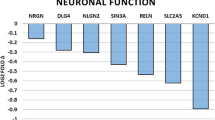Abstract
Focused-beam microwave irradiation (FBMI) is a relatively new method for euthanasia of small mammals and is available to most researchers. Compared with CO2 inhalation, this method of euthanasia has the advantage of preserving fast-degrading metabolites. But differences in brain RNA quantity and quality, gene expression and histology in mice euthanized by CO2 inhalation versus FBMI have not been investigated. Here the authors report that a smaller quantity of RNA was isolated from brains of mice euthanized by FBMI compared with those of mice euthanized by CO2 inhalation. They also found relative differences in the levels of the expression of some genes. These studies suggest that either method can be used for histological analysis or RNA isolation, but the authors caution against combining the techniques within a single study on gene expression.
This is a preview of subscription content, access via your institution
Access options
Subscribe to this journal
We are sorry, but there is no personal subscription option available for your country.
Buy this article
- Purchase on Springer Link
- Instant access to full article PDF
Prices may be subject to local taxes which are calculated during checkout






Similar content being viewed by others
References
Anonymous. AVMA Guidelines on Euthanasia (Formerly Report of the AVMA Panel on Euthanasia) (2007). <http://www.avma.org/issues/animal_welfare/euthanasia.pdf>.
Martoft, L. et al. Effects of CO2 anaesthesia on central nervous system activity in swine. Lab. Anim. 36, 115–126 (2002).
Martoft, L., Stødkilde-Jørgensen, H., Forslid, A., Pedersen, H.D. & Jørgensen, P.F. CO2 induced acute respiratory acidosis and brain tissue intracellular pH: a 31P NMR study in swine. Lab. Anim. 37, 241–248 (2003).
Brooks, S.P., Lampi, B.J. & Bihun, C.G. The influence of euthanasia methods on rat liver metabolism. Contemp. Top. Lab. Anim. Sci. 38, 19–24 (1999).
Al-Mousawi, A.M. et al. Impact of anesthesia, analgesia, and euthanasia technique on the inflammatory cytokine profile in a rodent model of severe burn injury. Shock 34, 261–268 (2010).
Berger-Sweeney, J., Berger, U.V., Sharma, M. & Paul, C.A. Effects of carbon dioxide-induced anesthesia on cholinergic parameters in rat brain. Lab. Anim. Sci. 44, 369–371 (1994).
Blank, C.L., Stavinoha, W.B. & Maruyama, Y. (eds.) Advances in the Biosciences vol. 45 (Pergamon, Oxford, 1983).
Jenden, D.J. Cholinergic Mechanisms and Psychopharmacology [Proceedings of a Symposium on Cholinergic Mechanisms and Psychopharmacology, held in La Jolla, California, March 28–31, 1977] (Plenum, New York, 1978).
Delaney, S.M. & Geiger, J.D. Brain regional levels of adenosine and adenosine nucleotides in rats killed by high-energy focused microwave irradiation. J. Neurosci. Methods 64, 151–156 (1996).
Murphy, E.J. Brain fixation for analysis of brain lipid-mediators of signal transduction and brain eicosanoids requires head-focused microwave irradiation: an historical perspective. Prostaglandins Other Lipid Mediat. 91, 63–67 (2010).
Jing, E., Nillni, E.A., Sanchez, V.C., Stuart, R.C. & Good, D.J. Deletion of the Nhlh2 transcription factor decreases the levels of the anorexigenic peptides alpha melanocyte-stimulating hormone and thyrotropin-releasing hormone and implicates prohormone convertases I and II in obesity. Endocrinology 145, 1503–1513 (2004).
Hendrickx, J.F., Eger, E.I. 2nd, Sonner, J.M. & Shafer, S.L. Is synergy the rule? A review of anesthetic interactions producing hypnosis and immobility. Anesth. Analg. 107, 494–506 (2008).
Vella, K.R., Burnside, A.S., Brennan, K.M. & Good, D.J. Expression of the hypothalamic transcription factor Nhlh2 is dependent on energy availability. J. Neuroendocrinol. 19, 499–510 (2007).
Denisov, V., Strong, W., Walder, M., Gingrich, J. & Wintz, H. Development and validation of RQI: An RNA quality indicator for the Experion automated electrophoresis system. Bio-Rad Bulletin #5761 (2008). <http://biorad-ads.com/pdf/Bulletin_5761.pdf>.
Wankhade, U.D. & Good, D.J. Melanocortin 4 receptor is a transcriptional target of nescient helix-loop-helix-2. Mol. Cell. Endocrinol. 341, 39–47 (2011).
Fox, D.L. & Good, D.J. Nhlh2 interacts with STAT3 to regulate transcription of prohormone convertase 1/3. Mol. Endocrinol. 22, 1438–1448 (2008).
Livak, K.J. & Schmittgen, T.D. Analysis of relative gene expression data using real-time quantitative PCR and the 2(-Delta Delta C(T)) Method. Methods 25, 402–408 (2001).
Seidah, N.G. et al. Cloning and primary sequence of a mouse candidate prohormone convertase PC1 homologous to PC2, Furin, and Kex2: distinct chromosomal localization and messenger RNA distribution in brain and pituitary compared to PC2. Mol. Endocrinol. 5, 111–122 (1991).
Young, J.I. et al. Authentic cell-specific and developmentally regulated expression of pro-opiomelanocortin genomic fragments in hypothalamic and hindbrain neurons of transgenic mice. J. Neurosci. 18, 6631–6640 (1998).
Lechan, R.M. & Jackson, I.M. Immunohistochemical localization of thyrotropin-releasing hormone in the rat hypothalamus and pituitary. Endocrinology 111, 55–65 (1982).
Mountjoy, K.G., Mortrud, M.T., Low, M.J., Simerly, R.B. & Cone, R.D. Localization of the melanocortin-4 receptor (MC4-R) in neuroendocrine and autonomic control circuits in the brain. Mol. Endocrinol. 8, 1298–1308 (1994).
Lawrance, C.C., Lucas, E.A., Clarke, S.L., Smith, B.J. & Kuvibidila, S. Differential effects of isoflurane and CO2 inhalation on plasma levels of inflammatory markers associated with collagen-induced arthritis in DBA mice. Int. Immunopharmacol. 9, 807–809 (2009).
Vedell, P.T., Svenson, K.L. & Churchill, G.A. Stochastic variation of transcript abundance in C57BL/6J mice. BMC Genomics 12, 167 (2011).
Conlee, K.M., Stephens, M.L., Rowan, A.N. & King, L.A. Carbon dioxide for euthanasia: concerns regarding pain and distress, with special reference to mice and rats. Lab. Anim. 39, 137–161 (2005).
Antognini, J.F., Barter, L. & Carstens, E. Overview movement as an index of anesthetic depth in humans and experimental animals. Comp. Med. 55, 413–418 (2005).
Author information
Authors and Affiliations
Corresponding author
Ethics declarations
Competing interests
The authors declare no competing financial interests.
Rights and permissions
About this article
Cite this article
Zhang, H., Good, D. Comparison of hypothalamic mRNA levels in mice euthanized by CO2 inhalation and focused-beam microwave irradiation. Lab Anim 40, 313–318 (2011). https://doi.org/10.1038/laban1011-313
Received:
Accepted:
Published:
Issue Date:
DOI: https://doi.org/10.1038/laban1011-313



